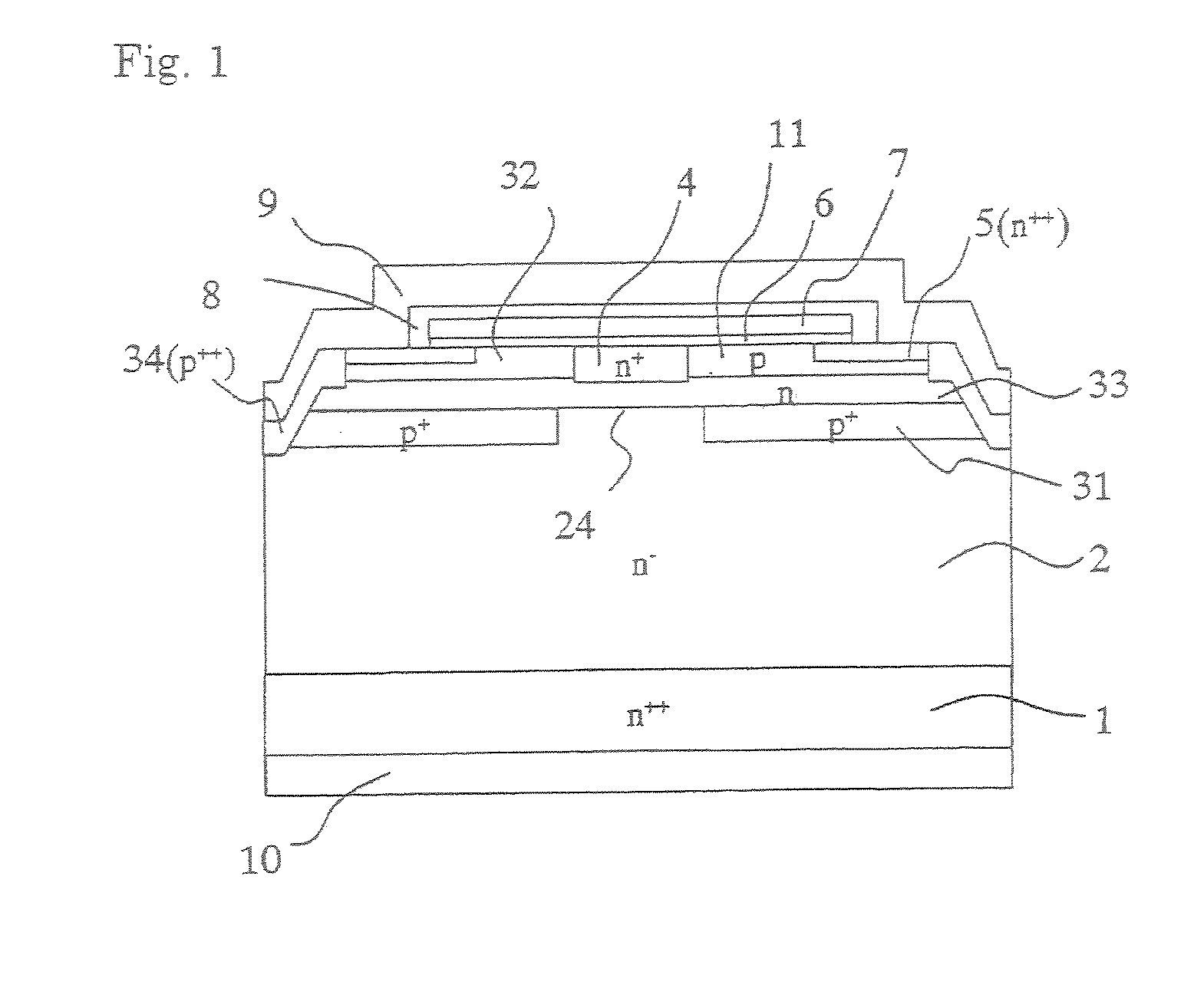Silicon carbide mos field-effect transistor and process for producing the same
a field-effect transistor and silicon carbide technology, applied in the direction of basic electric elements, electrical apparatus, semiconductor devices, etc., can solve the problems of reducing the efficiency of the field-effect transistor, so as to achieve low on-resistance, high blocking voltage, and high accuracy
- Summary
- Abstract
- Description
- Claims
- Application Information
AI Technical Summary
Benefits of technology
Problems solved by technology
Method used
Image
Examples
embodiment 1
[0060]FIG. 1 is a cross section of the unit cell of a SiC vertical MOSFET in Embodiment 1 of this invention. In this configuration, an n-type drift layer 2 doped with nitrogen in a concentration of 5×1015 cm−3 is deposited in a thickness of 15 μm on an n-type SiC substrate 1 doped with nitrogen in a concentration of 5×1018 cm−3 and having a thickness of about 300 μm. A p-type layer 31 doped with aluminum in a concentration of 2×1018 cm−3 is formed across a depth of 0.5 μm from the surface thereof and the p-type layer 31 is provided with a partial depletion part 24 having a width of about 2.0 μm. An n-type layer 33 doped with nitrogen in a concentration of 1×1016 cm−3 is deposited in a thickness of 1.0 μm on the surface of the p-type layer 31 and the surface of the n-type drift layer 2 of the partial depletion part 24 and a p-type layer 32 doped with aluminum in a concentration of 5×1015 cm−3 is deposited in a thickness of 0.5 μm on the surface of the n-type layer 33. On the surface ...
embodiment 2
[0064]FIG. 3 is a cross section of the unit cell of an SiC vertical MOSFET in Embodiment 2 of this invention. In this configuration, the n-type drift layer 2 doped with nitrogen in a concentration of 5×1015 cm−3 was deposited in a thickness of 15 μm on the substrate 1 doped with nitrogen in a concentration of 5×1018 cm−3 and having a thickness of about 300 μm. The p-type layer 31 doped with aluminum in a concentration of 2×1018 cm−3 was deposited in a thickness of 0.5 μm on the resultant surface, and the p-type layer 31 was provided with a partial depletion part 24 having a width of about 2.0 μm. On the surface of the p-type layer 31 and the surface of the n-type drift layer 2 of the partial depletion part 24, the n-type layer 33 doped with nitrogen in a concentration of 1×1016 cm−3 was deposited in a thickness of 1.0 μm. Further, on the surface of the n-type layer 33, the p-type layer 32 doped with aluminum in a concentration of 5×1015 cm−3 was deposited in a thickness of 0.5 μm. O...
embodiment 3
[0066]FIG. 4 is a cross section of the SiC vertical MOSFET in Embodiment 3 of this invention. In the drawing, the sites bearing the same reference numerals as in FIG. 1 designate the same parts and the basic configuration is identical with that of Embodiment 1 of FIG. 1 except that a high-concentration n-type layer 41 is disposed as parted on the opposite sides of the n-type base region 4. The high-concentration n-type layer 41 was simultaneously formed with the n-type source layer 5 and was equaled therewith in impurity concentration and depth from the surface and was given a length substantially equal to the partial depletion part 24. The provision of this layer was effective in preventing refinement of cells and concentration of an electric current because it enabled equalizing the two channel regions 11 contained in the unit cell in terms of length and imparting a prescribed relation to their relative positions. This operational effect may be well comprehended from the method of...
PUM
 Login to View More
Login to View More Abstract
Description
Claims
Application Information
 Login to View More
Login to View More - R&D
- Intellectual Property
- Life Sciences
- Materials
- Tech Scout
- Unparalleled Data Quality
- Higher Quality Content
- 60% Fewer Hallucinations
Browse by: Latest US Patents, China's latest patents, Technical Efficacy Thesaurus, Application Domain, Technology Topic, Popular Technical Reports.
© 2025 PatSnap. All rights reserved.Legal|Privacy policy|Modern Slavery Act Transparency Statement|Sitemap|About US| Contact US: help@patsnap.com



